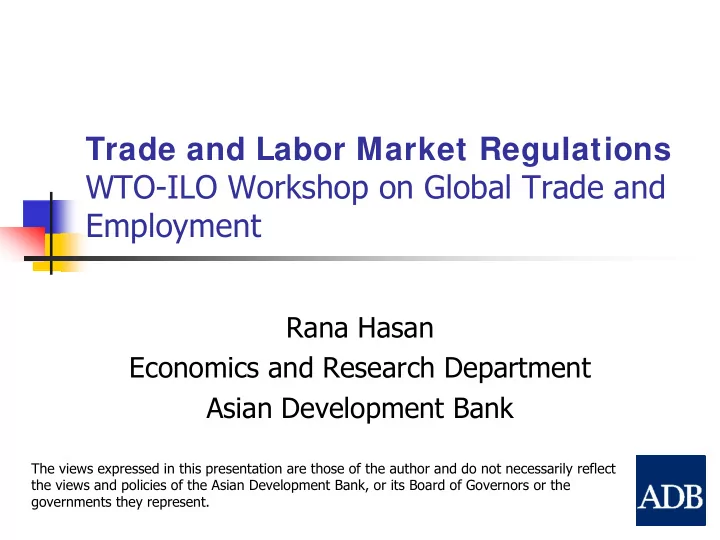

Trade and Labor Market Regulations WTO-ILO Workshop on Global Trade and Employment Rana Hasan Economics and Research Department Asian Development Bank The views expressed in this presentation are those of the author and do not necessarily reflect the views and policies of the Asian Development Bank, or its Board of Governors or the governments they represent.
Trade and Labor Market Regulations 1970s-2008: Trade volumes have increased Trade protection has declined Key questions: How has trade’s impact on labor market (LM) outcomes been influenced by labor regulations? How has trade affected labor regulations? Labor regulations/institutions Employment protection laws (severance pay; restrictions on firing) Minimum wages Mandated benefits (social insurance, vacation pay, maternity leave, etc.) Unions and collective bargaining
Channels through which trade can affect LM outcomes: Growth/Efficiency Efficiency gains Greater variety Distribution Freer trade returns to different types of labor The need for empirical work arises because of: Lack of clear theoretical predictions on the impact of trade on growth rates Adjustment costs (imperfect factor mobility) complicates predictions even more
A simple but useful empirical framework: ln y protection protection * regulation it 1 it 1 2 it 1 i i t it where y is some LM outcome (unemployment rate; poverty rate; industry wage premium; share of contract workers, etc.); t is time, i represents a cross-sectional unit (country, state, industry); and regulation captures some measure of labor regulation. Effect of trade on y depends in part on the interaction between protection and LM regulation measure, β 2 .
India-specific work using this framework Dramatic trade liberalization (e.g., mean tariffs from 128 percent before July 1991 to roughly 35 percent by 1997-98.) State-level variation in labor regulations (especially Industrial Disputes Act) Besley and Burgess (2004) Hasan, Mitra, and Ramaswamy (2007) Bhatacharjea (2008) OECD (2007) Gupta, Hasan, and Kumar (2009)
Some results Hasan, Mitra, and Ural (2007): States whose workers are on average more exposed to trade tend to have lower poverty rates (and poverty gaps). This beneficial effect of trade openness is more pronounced in urban sectors of states that have more flexible labor market institutions. Hasan, Mitra, and Ranjan (2009): Little evidence to support the view that unemployment rises with trade liberalization. On the contrary, there is evidence that unemployment, especially urban unemployment, declines with trade liberalization in states with more flexible labor markets. At the same time, it should be noted that Hasan, Mitra, and Ramaswamy (2007) find evidence consistent with the notion that trade liberalization has reduced the bargaining power of workers in India’s formal manufacturing sector.
Putting these results in broader perspective How generalizable are these results? Freeman (2009): “Overall, Indian labor institutions come closer to fitting the 1990 World Bank [World Development Report] view that regulations do more harm than good than the institutions in other countries…” Our results, and comparisons of India’s labor regulations with those of other countries using datasets such as those of Botero et al (2004) and the World Bank’s Doing Business indicators suggests the problem is with employment protection and adjustment laws. In other areas (e.g., severance pay, minimum wages, etc.) India is not unusual.
Future work and remaining challenges Data and measurement: Liberalization: Can we develop measures of liberalization in services? (In the Indian context, Cain et al (2009) finds services to be where the action is at in terms of rising inequality – and liberalization has contributed.) Labor Regulations: In addition to the approaches used, it will be useful to administer focused questionnaires to key stakeholders – e.g., evaluate common managerial tasks relating to “reallocating work,” “disciplining misconduct,” “deciding on annual wage increases,” or “going to the dispute settlement body.” Labor force surveys and enterprise surveys: Panel data and matched worker-enterprise data in Asia is all too scarce.
Examine trade-labor regulation linkages in the context of: (i) job separations; and (ii) quality of jobs (as proxied by share of casual and own-account workers) Examine trade-labor regulation linkages using establishment level data (formal and informal).
The technology-labor regulation- social protection nexus Technology (trade) can be disruptive for workers LM and other regulations have been used as substitutes for weak social protection mechanisms We seem to see the adverse implications of this approach in LM outcomes plus firm size distributions that are highly skewed toward small firm size (Figure 1 from ADB 2009) This leads to a viscous cycle of less Spreading Machine than optimum size, low adoption of new technology (Figure 2), and low skills among the workforce What would a “better” set of LM regulations and social protection system look like?
Recommend
More recommend